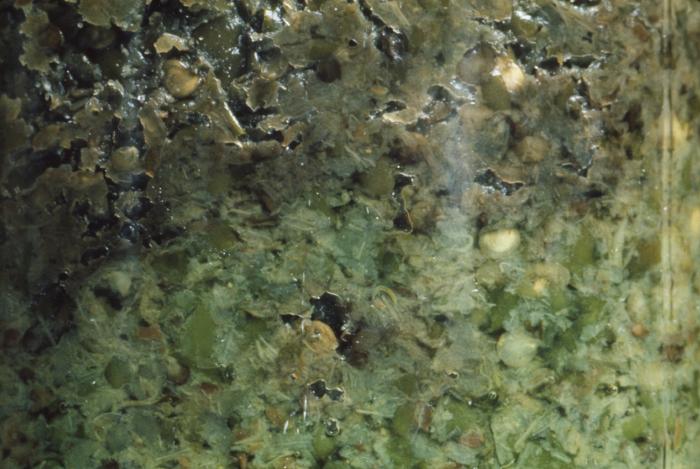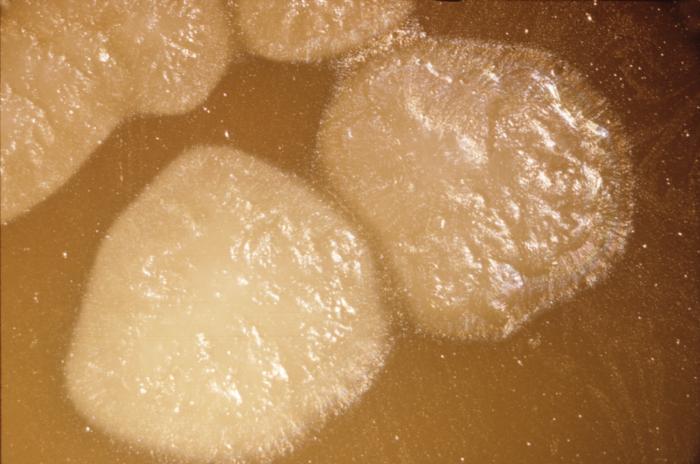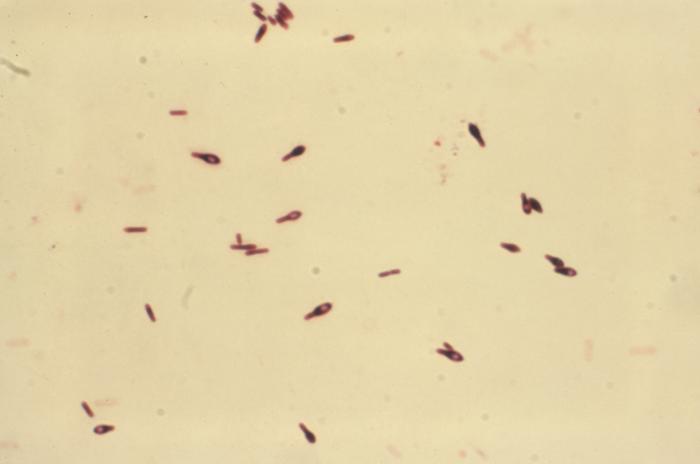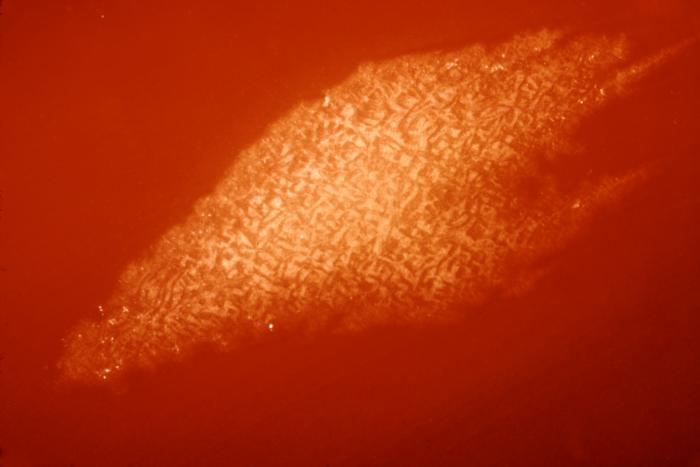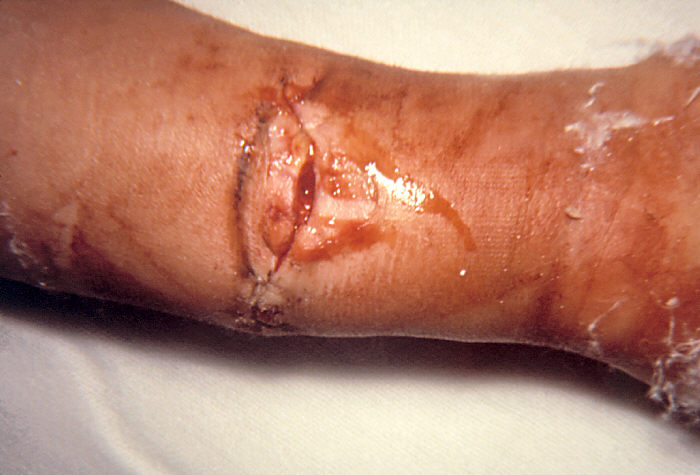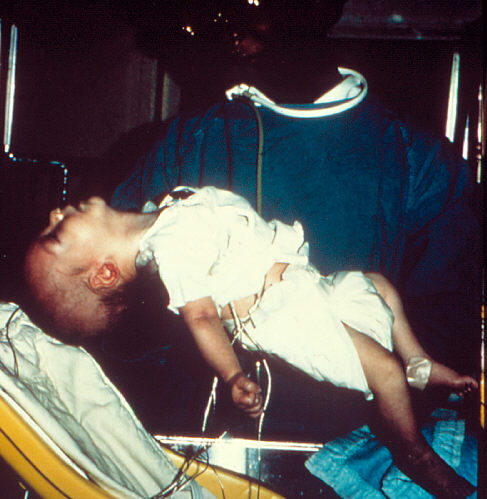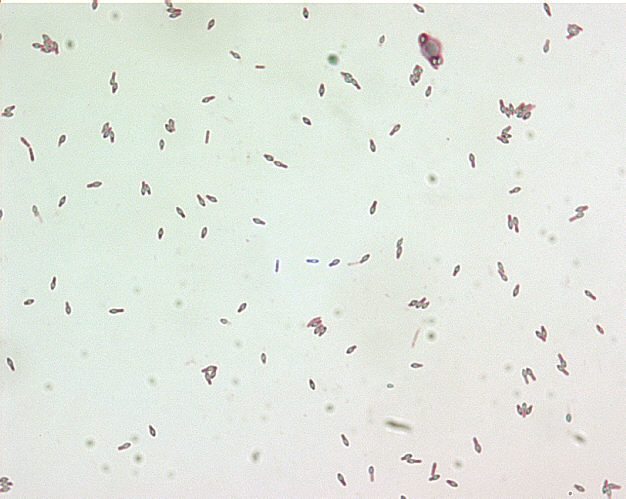Botulism pathophysiology: Difference between revisions
No edit summary |
|||
| Line 14: | Line 14: | ||
==Images== | ==Images== | ||
<gallery> | |||
Image:Botulism outbreak.jpg|This is a close up of contaminated Jalapeño peppers involved in an outbreak of botulism in Pontiac, Michigan, April, 1977. Ingestion of botulinal toxin results in an illness of variable severity. Common symptoms are diplopia, blurred vision, and bulbar weakness. Symmetric paralysis may progress rapidly. | |||
Image:Botulism type E.jpg|These are Clostridium botulinum Type E colonies displaying an opaque zone grown on a 48hr egg yolk agar plate; Mag. 1.9 C. botulinum Type E is an indigenous organism in the aquatic environment, and is the type mainly associated with botulism from seafood products. It is a Gram-positive, anaerobic, -forming food borne pathogen. | |||
Image:Botulism type A.jpg|This Gram-stained micrograph of Clostridium botulinum Type-A in thioglycollate broth was incubated for 48hrs at 35°C. C. botulinum is the bacterium responsible for the condition known as botulism, producing a neurotoxin the effects of which may be neutralized by various therapeutic agents. | |||
C. botulinum Type E is an indigenous organism in the aquatic environment, and is the type mainly associated with botulism from seafood products. It is a Gram-positive, anaerobic, | Image:Botulism 2 type A.jpg|This is a Clostridium botulinum type A colony grown on a 72 hour blood agar plate; Magnification 5X. The bacterium C. botulinum produces a nerve toxin, which causes the rare, but serious paralytic illness Botulism. There are seven types of botulism toxin designated by the letters A through G; only types A, B, E and F cause illness in humans. | ||
Image:Botulism 3 type A.jpg|These are Clostridium botulinum Type A colonies, Strain 2, grown on a 48hr blood agar plate. The bacterium C. botulinum produces a nerve toxin, which causes the rare, but serious paralytic illness Botulism. There are seven types of botulism toxin designated by the letters A through G; only types A, B, E and F cause illness in humans. | |||
Image:Botulism wound.jpg|Wound botulism involvement of compound fracture of right arm. 14-year-old boy fractured his right ulna and radius and subsequently developed wound botulism. | |||
Image:Botulism infant.jpg|Six week old infant with botulism. Six week old infant with botulism, which is evident as a marked loss of muscle tone, especially in the region of the head and neck. | |||
C. botulinum is the bacterium responsible for the condition known as botulism, producing a neurotoxin the effects of which may be neutralized by various therapeutic agents. | Image:Botulism spores.jpg|Clostridium botulinum spores stained with Malachite Green Stain. The endospores of C. botulinum when stained using the Malachite Green staining method will appear as green spheres, while the bacilli themselves will turn purple in color. | ||
</gallery> | |||
==References== | ==References== | ||
{{Reflist|2}} | {{Reflist|2}} | ||
Revision as of 19:53, 16 February 2012
|
Botulism Microchapters |
|
Diagnosis |
|---|
|
Treatment |
|
Case Studies |
|
Botulism pathophysiology On the Web |
|
American Roentgen Ray Society Images of Botulism pathophysiology |
|
Risk calculators and risk factors for Botulism pathophysiology |
Editor-In-Chief: C. Michael Gibson, M.S., M.D. [1] Michael Maddaleni, B.S.
Overview
Microbiology
Clostridium botulinum is an obligate anaerobe that forms spores. The natural habitat for the Clostridium botulinum spores is the soil. The species of Clostridium botulinum is made up of 4 genetically diverse groups that do not have much in common other than the fact that they all produce the botulinum toxin[1]. The botulinum toxin itself exists as 7 different antigenic types and these 7 antigenic types have been assigned a series of letters: A, B, C, D, E, F, G[1]. These toxins have a specific definition, and they are defined by their inability to cross neutralize the other types. For example, Anti-A toxin can not neutralize any of the other toxin types (B-G). It should be noted that Clostridium baratii and Clostridium butyricum can also produce the botulinum toxin[1].
The botulinum molecule itself is composed of a heavy chain as well as a light chain polypeptide. It is referred to as a dichain polypeptide. The light chain of the toxin contains an endopeptidase that blocks acetylcholine-containing vesicles from being able to fuse with the membrane at the end of the motor neuron. If acetycholine is not present, it will result in flaccid muscle paralysis[1].
Many people may not realize it, but the commercial therapeutic procedure termed "Botox" actually contains the botulinum toxin. However, there is a very small amount of it present, otherwise it would present an extensive danger. A vial of type A preparation, which is currently licensed in the US, contains only about 0.005% of the lethal oral dose and 0.3% of the lethal inhalation dose[1].
Images
-
This is a close up of contaminated Jalapeño peppers involved in an outbreak of botulism in Pontiac, Michigan, April, 1977. Ingestion of botulinal toxin results in an illness of variable severity. Common symptoms are diplopia, blurred vision, and bulbar weakness. Symmetric paralysis may progress rapidly.
-
These are Clostridium botulinum Type E colonies displaying an opaque zone grown on a 48hr egg yolk agar plate; Mag. 1.9 C. botulinum Type E is an indigenous organism in the aquatic environment, and is the type mainly associated with botulism from seafood products. It is a Gram-positive, anaerobic, -forming food borne pathogen.
-
This Gram-stained micrograph of Clostridium botulinum Type-A in thioglycollate broth was incubated for 48hrs at 35°C. C. botulinum is the bacterium responsible for the condition known as botulism, producing a neurotoxin the effects of which may be neutralized by various therapeutic agents.
-
This is a Clostridium botulinum type A colony grown on a 72 hour blood agar plate; Magnification 5X. The bacterium C. botulinum produces a nerve toxin, which causes the rare, but serious paralytic illness Botulism. There are seven types of botulism toxin designated by the letters A through G; only types A, B, E and F cause illness in humans.
-
These are Clostridium botulinum Type A colonies, Strain 2, grown on a 48hr blood agar plate. The bacterium C. botulinum produces a nerve toxin, which causes the rare, but serious paralytic illness Botulism. There are seven types of botulism toxin designated by the letters A through G; only types A, B, E and F cause illness in humans.
-
Wound botulism involvement of compound fracture of right arm. 14-year-old boy fractured his right ulna and radius and subsequently developed wound botulism.
-
Six week old infant with botulism. Six week old infant with botulism, which is evident as a marked loss of muscle tone, especially in the region of the head and neck.
-
Clostridium botulinum spores stained with Malachite Green Stain. The endospores of C. botulinum when stained using the Malachite Green staining method will appear as green spheres, while the bacilli themselves will turn purple in color.
References
- ↑ 1.0 1.1 1.2 1.3 1.4 Arnon SS, Schechter R, Inglesby TV, Henderson DA, Bartlett JG, Ascher MS, Eitzen E, Fine AD, Hauer J, Layton M, Lillibridge S, Osterholm MT, O'Toole T, Parker G, Perl TM, Russell PK, Swerdlow DL, Tonat K (2001). "Botulinum toxin as a biological weapon: medical and public health management". JAMA : the Journal of the American Medical Association. 285 (8): 1059–70. PMID 11209178. Retrieved 2012-02-16. Unknown parameter
|month=ignored (help)
